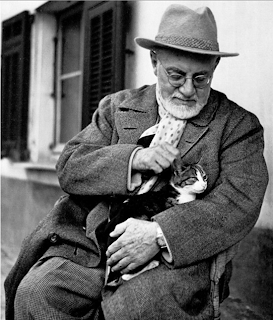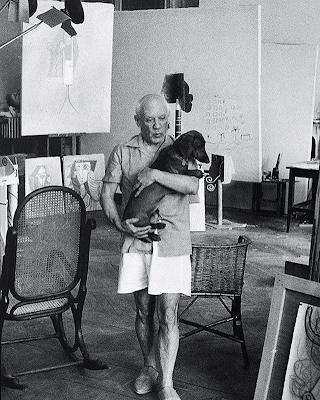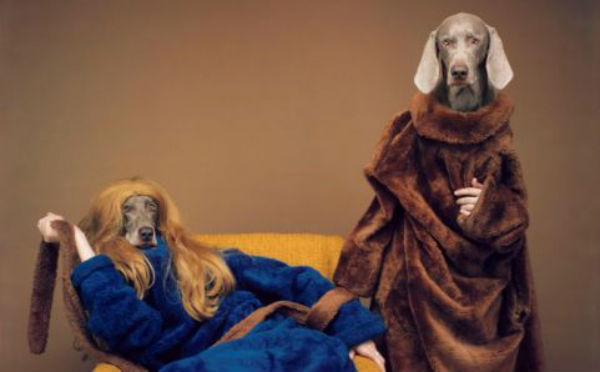
Cats in Art: Franz Marc, The White Cat, 1912
Some people say they are a “cat person” or a “dog person”. You might say the same thing as an artist. Let’s look at art and artists who show their love for dogs and cats. *many of these artists had BOTH!

Utagawa Hiroshige II, A White Cat Playing With String, 1863
Some artists show their feline subject at play.

Marc Chagall, La Poete, 1949/50
And some show kitty jumping over the moon

Marguerite Gérard, The Cat’s Lunch or Young Girl Giving Milk to Her Cat, late 18th century – early 19th century
Some artists show the care they give to their cats. What is needed to take care of a pet? Who has a pet that’s spoiled?
 |
 Matisse-Henri-Girl-with-A-Black-Cat-1910
|
Henri Matisse, whose art you have seen before, included a cat with this portrait of a young girl.

Andy Warhol made many colorful versions of cats.
As an artist you can choose realistic colors (colors true to life) for your pet or bold colors like Andy.
Artist Laurel Burch created colorful cats filled with patterns. Think about the patterns you might add to your art.

Seated cats c. 1900
attributed to Émile Gallé (1846–1904)
Some artists create cats and dogs in 3D like these ceramic cats and some work in 2D like drawing and painting.
Artists that create ceramics use what art medium?

Attic Red-Figure Pelike, about 470 BC, attributed to the Triptolemos Painter. Terracotta, 14 3/16 × 9 3/4 in. 86.AE.195.
And some simply show that animals were part of their lives as in this ancient Greek pottery.
Mary Cassatt, Little Girl in a Blue Armchair
Let’s look at artists who were inspired by dogs. Mary Cassatt, shows how a pup can be a companion and friend keeping the little girl in the blue armchair company
 |
 |
Hockney and his pups Stanley and Boodgie ...a series of more than 40 paintings
Some artists love their pets so much that they will paint many versions of their pup, a series. Look how many paintings David Hockney created of his Dachshunds. See if you spot another artist that had a Dachshund.

Pompeii’s Beware of the Dog Mosaic This mosaic was discovered in the House of the Tragic Poet in the Ancient Roman town of Pompeii. The words inscribed at the bottom of the mosaic, “Cave Canem,” literally translate to “beware of the dog.” Researchers believe this symbol was intended to bring attention to the presence of household dogs rather than signal danger. Jeff Koons, Balloon Dog (Orange), 1994-2000, mirror-polished stainless steel with transparent color coating
When I made Balloon Dog, I wanted to make a piece that reflected the joy of celebrating a birthday or a party. - Jeff Koons
Keith Haring’s Dancing Dogs In the 1980s, Keith Haring gained fame by posting his art in public spaces, including subways in New York City. Dancing dogs appear repeatedly in his work, and have become one of his most recognized trademarks. Haring’s dogs are notably human-like as they dance on two legs, but, interestingly, when they appear alongside human forms, they are portrayed as significantly larger. |
|
 |
 |
Picasso had many dogs (and cats), but Pablo Picasso was his beloved dachshund, Lump. Lump means "rascal" in German, and this puppy was a rascal! He would keep Picasso company while he painted, and he was fond of chewing on a small bunny sculpture Picasso made. Picasso loved Lump dearly... he would hold him like he was a baby, and feed him at the dinner table on a plate that he painted just for him!"
Could you draw a dog with one continuous line?
Frida Kahlo loved animals and had many pets. She considered them her children she was not able to have after a serious bus accident. Out of her 143 paintings, 55 of them are self-portraits featuring her beloved animals.
Among her pets she kept hairless Mexican dogs, her favorite named Mr. Xoloti, one of which she features in this work. Itzcuintli dogs are very rare and were highly prized by the Aztecs, which may explain their appeal to Kahlo, who was very proud of her MesoAmerican heritage.

William Wegman fell in love with his first pup Man Ray early in his career The dog was a central figure in Wegman’s photographs, known for his serious stare.
What artist tool is used to make a photograph?
Will you create art inspired by your pet?





















